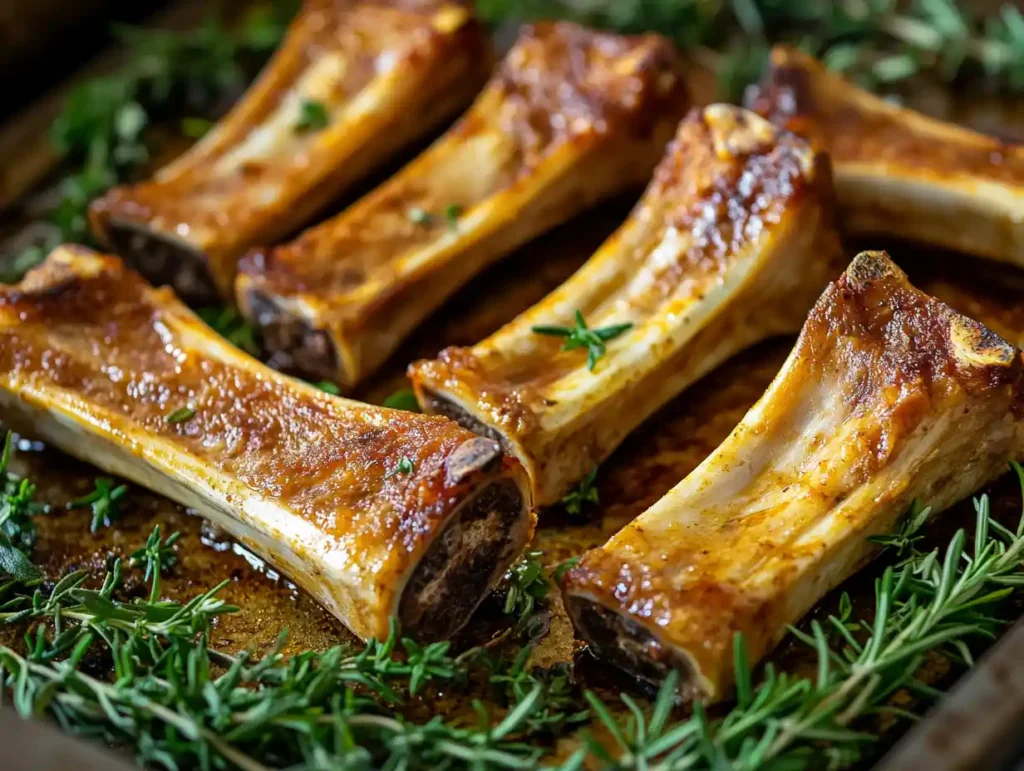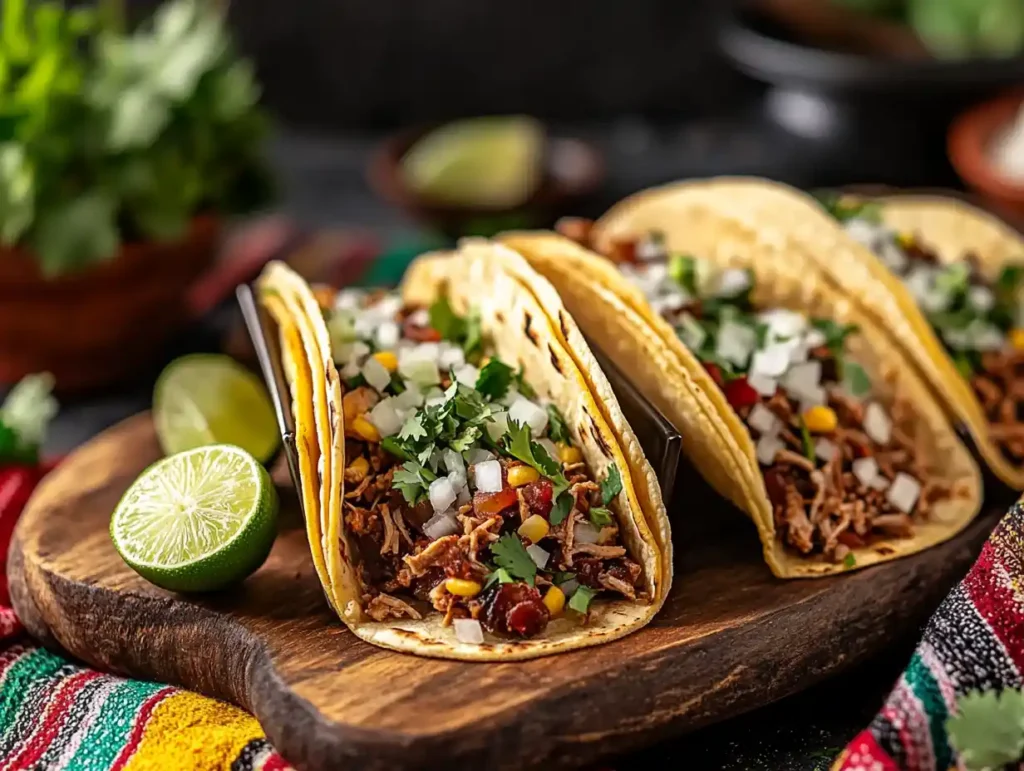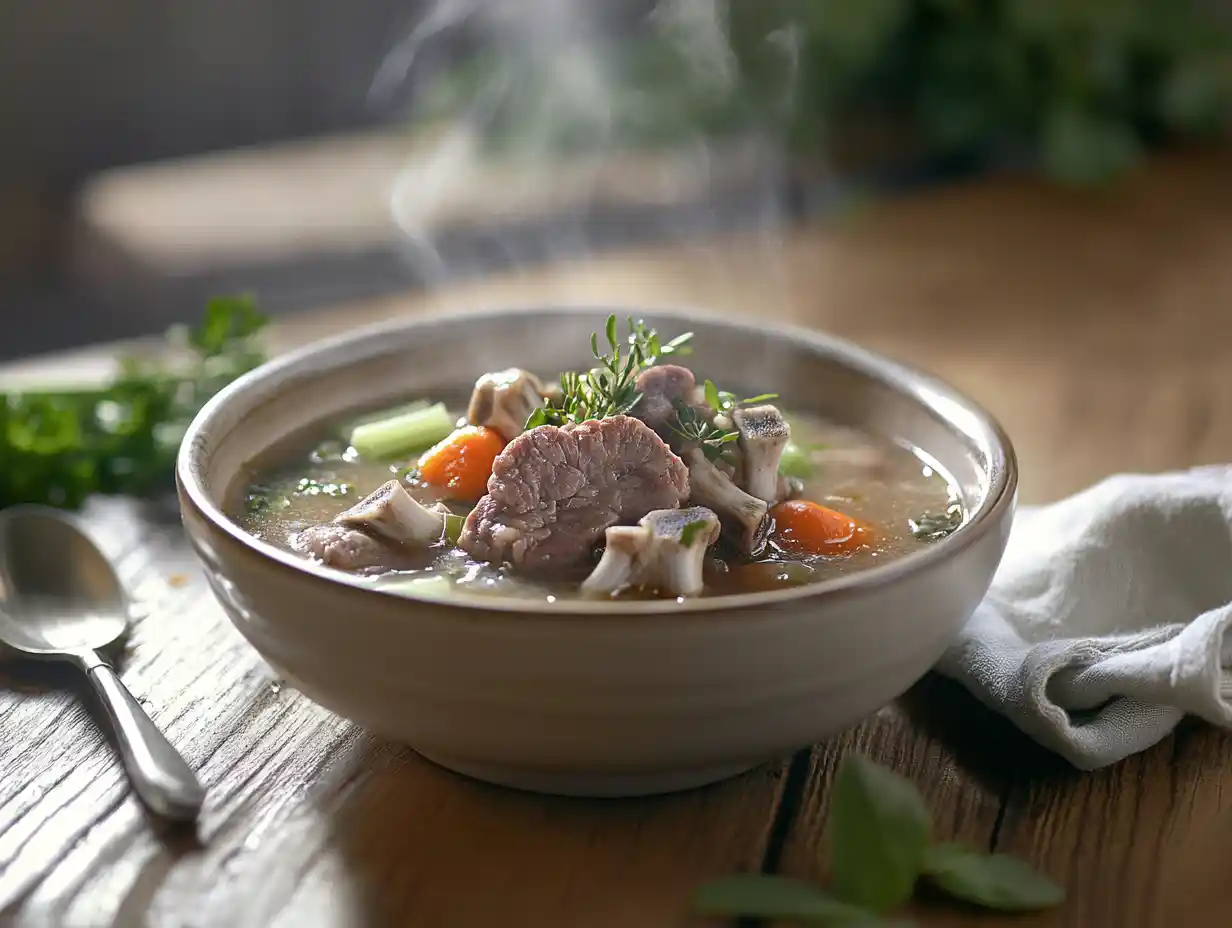Soup bones are essential in many cuisines, adding flavor and nutrients to broths and stews. These bones often have bits of meat still attached, prompting a common question: Can you eat the meat from soup bones?
The simple answer is “Yes.” The meat on soup bones is edible and nutritious, offering protein and other health benefits. Its texture and taste depend on the cooking method and the type of bone used. With the right preparation, this often-overlooked meat can enhance meals and reduce waste in the kitchen.
This article explores soup bones, their uses, and the nutritional value of their meat. It also shares tips on cooking and using this resource to its fullest. Let’s dive in and uncover the potential of this underrated ingredient.
What Are Soup Bones?
Soup bones are a key ingredient in many recipes, offering both flavor and nutritional value. Typically sourced from beef, pork, or chicken, these bones often retain small amounts of meat, cartilage, and marrow. While they are mainly used to create flavorful broths, the meat on soup bones can be a tasty and practical addition to meals. Therefore, understanding how to use them effectively can help you minimize waste and maximize flavor.
Types of Soup Bones
Different types of soup bones bring unique qualities to a dish, so it’s important to choose the right ones for your cooking. Here are the most common types:
- Beef Bones: These are large and filled with marrow, which makes them ideal for creating hearty broths. Furthermore, the attached meat, though tough at first, becomes tender after slow cooking.
- Pork Bones: These smaller bones are popular in Asian cuisines and contribute a rich, savory depth to dishes. The meat on pork bones is typically soft and flavorful when simmered.
- Chicken Bones: Often used in home kitchens, chicken bones are perfect for creating light, clear broths. Additionally, the small bits of meat on these bones can be shredded and added back into your soup or stew.
By selecting the right type of soup bones, you can ensure the dish achieves its intended flavor and texture.
Common Uses in Cooking
Soup bones are incredibly versatile, making them a staple in traditional and modern recipes alike. They are most commonly used in:
- Broths and Stocks: These are essential bases for soups, gravies, and sauces, adding rich layers of flavor.
- Stews: Hearty stews benefit significantly from the nutrients and taste released by soup bones.
- Bone Broth: This popular health drink, made by simmering bones, delivers collagen, gelatin, and minerals that support joint and gut health.
Moreover, you can repurpose the meat from soup bones in a variety of creative dishes, reducing waste and adding extra depth to your meals.
Anatomy of Soup Bones
Knowing the anatomy of soup bones allows you to utilize them fully. Key components include:
- Bone: The marrow and collagen within the bone release flavor and nutrients during cooking.
- Meat: Though often tough initially, this meat softens significantly when cooked slowly and thoroughly.
- Connective Tissue: This breaks down into gelatin, giving broths and stews a smooth, velvety texture.
When you understand these components, it becomes easier to extract their full potential, ensuring your dishes are both flavorful and nutritious.
Is the Meat from Soup Bones Edible?
Yes, the meat from soup bones is absolutely edible and can be a valuable addition to your meals. However, its taste, texture, and usability depend heavily on how it’s prepared. When cooked properly, this meat transforms from tough and chewy into tender and flavorful. Knowing the right cooking methods and techniques is key to making the most of the meat attached to soup bones.
Cooking Methods That Soften Meat
Cooking soup bones releases their flavors and nutrients into the liquid, but it also tenderizes the meat. Here are some popular cooking methods that work well:
- Slow Cooking: This method uses low heat over an extended period, allowing the meat to soften and fall off the bones naturally. It’s perfect for tough cuts like shanks or oxtails.
- Simmering: Cooking soup bones in water or broth over medium heat helps extract flavors while keeping the meat juicy. Adding seasonings enhances the overall taste.
- Pressure Cooking: For a faster option, a pressure cooker uses high heat and steam to break down connective tissue and tenderize meat in a fraction of the time.
Using these methods, you can ensure the meat from soup bones becomes tender enough to enjoy in a variety of dishes.
Flavor and Texture of Soup Bone Meat
The flavor of soup bone meat is unique and often richer than other cuts of meat. As the bones cook, their marrow and connective tissue release savory notes into the broth. This process also enhances the meat’s natural flavor.
In terms of texture, meat from soup bones can initially feel tough or fibrous. However, long cooking times and proper heat levels turn it into a soft, melt-in-your-mouth delight. Adding complementary spices or vegetables can further elevate its taste.
Identifying Edible Meat from Bones
Not all parts of a soup bone are equally enjoyable to eat. When using soup bones, look for these edible components:
- Meat Strips: These are the obvious portions clinging to the bones and are usually the easiest to consume.
- Tendons and Connective Tissues: These parts break down into gelatin during cooking, becoming soft and flavorful.
- Fatty Bits: These add richness to the broth and can be eaten for an extra burst of flavor.
With a little attention, you can spot the edible portions on soup bones and use them effectively in your recipes.
Nutritional Value of Meat from Soup Bones
The meat from soup bones is not just tasty; it also provides a variety of essential nutrients that can benefit your health. Many people overlook this resource, but it offers significant protein, vitamins, and minerals that support overall well-being. Additionally, the breakdown of connective tissue and marrow adds further health-boosting compounds like collagen and gelatin.
Protein Content
Soup bone meat is an excellent source of protein, which is crucial for muscle growth, repair, and energy. Even small amounts of meat clinging to bones can contribute to your daily protein intake. For example, the leftover meat on beef or pork bones often contains dense protein fibers that remain intact during cooking. Consuming this meat as part of a soup or stew can help you meet your dietary needs, especially if you’re looking for a sustainable way to add protein to your meals.
Collagen and Gelatin Benefits
One of the standout nutritional benefits of soup bones comes from collagen and gelatin. When soup bones simmer for hours, the collagen in connective tissues and bones breaks down into gelatin, which is easily absorbed by the body. Collagen and gelatin offer several health benefits, such as:
- Joint Health: They help maintain cartilage and reduce joint pain or stiffness.
- Skin Elasticity: Collagen improves skin elasticity, reducing the appearance of wrinkles.
- Digestive Health: Gelatin soothes the digestive tract, promoting better gut health.
By consuming soup bone meat along with the broth, you’ll get a natural source of these compounds without relying on supplements.
Essential Vitamins and Minerals
The meat and marrow from soup bones are rich in essential vitamins and minerals, including:
- Iron: Vital for oxygen transport in the blood, especially beneficial for preventing anemia.
- Zinc: Boosts the immune system and supports wound healing.
- Calcium and Phosphorus: Strengthen bones and teeth while promoting overall skeletal health.
- B Vitamins: Support energy production and brain function.
The cooking process often releases these nutrients into the broth, meaning that consuming both the meat and the liquid maximizes the nutritional benefits. This makes soup bone meat an excellent option for those looking to add more nutrient-dense foods to their diet.
Health Benefits and Risks
The meat from soup bones offers numerous health benefits when prepared and consumed correctly. However, as with any food, it’s essential to understand potential risks to make informed choices. By balancing the advantages with proper precautions, you can enjoy this often-overlooked ingredient safely and confidently.
Health Benefits
Soup bone meat provides a wealth of health benefits, making it a valuable addition to many diets. Some of the key benefits include:
- Boosting Immunity: The nutrients in soup bone meat, such as zinc and iron, play a crucial role in supporting immune function. Eating this meat alongside the broth ensures you receive these nutrients in a bioavailable form.
- Aiding Recovery: After illness or injury, the combination of protein and collagen in soup bone meat promotes tissue repair and recovery. It’s especially useful for those recovering from surgeries or managing joint issues.
- Improving Gut Health: The gelatin released from connective tissue soothes the digestive lining, reducing inflammation and promoting a healthy gut microbiome.
- Supporting Bone Health: The minerals from soup bones, including calcium and phosphorus, contribute to stronger bones and teeth when consumed regularly.
Incorporating soup bone meat into meals is an easy way to enjoy these benefits while reducing food waste.
Potential Risks of Eating Bone Meat
Although soup bone meat offers many benefits, there are a few risks to keep in mind. Proper preparation and sourcing are essential to ensure safety.
- Contaminants in Bones: If bones come from animals exposed to toxins, heavy metals, or poor farming practices, these contaminants can leach into the broth and meat. To avoid this, always source bones from reputable suppliers who follow organic or ethical farming standards.
- Improper Cooking: Undercooked meat on soup bones can harbor bacteria, leading to foodborne illnesses. To minimize this risk, always cook soup bones thoroughly at a safe temperature and for a long enough time to kill harmful pathogens.
- Choking Hazards: Small bone fragments can break off during cooking and pose a choking risk, particularly for children or pets. Strain your broth carefully and inspect the meat before serving.
By taking these precautions, you can safely enjoy the meat from soup bones and its many health benefits.
How to Maximize the Meat on Soup Bones
To get the most out of soup bones, it’s important to cook and store them effectively. By applying the right techniques, you can extract the maximum amount of meat and ensure none of this resource goes to waste. Additionally, incorporating leftover meat into creative recipes helps elevate your meals while keeping them budget-friendly and sustainable.
Cooking Techniques to Extract Meat

Extracting meat from soup bones requires proper cooking methods that soften tough fibers and release the meat naturally. Here are some techniques to achieve the best results:
- Simmering: Place the soup bones in a large pot of water with your choice of vegetables and seasonings. Let the pot simmer for several hours, periodically skimming off any foam. As the meat becomes tender, it will begin to separate from the bones.
- Roasting Before Cooking: Roasting the bones in the oven at 400°F (200°C) for about 30 minutes adds depth of flavor. Afterward, transfer the roasted bones to a pot for simmering or pressure cooking.
- Pressure Cooking: A pressure cooker is an efficient way to cook soup bones quickly. Within 30–45 minutes, the high heat and steam will soften the meat and release nutrients from the bones.
By experimenting with these methods, you can find the one that works best for your recipes and preferences.
Storing Leftover Meat
If you’ve cooked soup bones and have leftover meat, proper storage is crucial to maintain its quality and safety. Follow these steps to keep the meat fresh:
- Refrigeration: Place the cooked meat in an airtight container and store it in the fridge. Use it within 3–4 days to ensure freshness.
- Freezing: For longer storage, portion the meat into smaller servings and freeze it in freezer-safe bags or containers. Properly stored meat can last up to 3 months in the freezer.
- Labeling: Always label containers with the date to track how long the meat has been stored.
These storage tips will help you avoid spoilage and make it easier to repurpose the meat for future meals.
Recipe Ideas

The meat from soup bones is incredibly versatile and can be used in various dishes. Here are some creative ideas to inspire you:
- Soups and Stews: Add the shredded meat back into the broth along with vegetables and grains for a hearty meal.
- Tacos and Wraps: Use the meat as a filling for tacos or wraps, seasoned with spices like cumin and paprika.
- Stir-Fries: Toss the meat into a stir-fry with fresh vegetables and soy sauce for a quick and flavorful dish.
- Savory Pies: Mix the meat with gravy and vegetables as a filling for pot pies or pasties.
With these ideas, you can easily turn leftover meat into delicious meals while reducing food waste.
FAQs
Is soup bone meat safe to eat for everyone?
Yes, soup bone meat is generally safe for most people. However, those with allergies to specific animal proteins or dietary restrictions should verify the source of the bones and their preparation.
Can soup bone meat be used in baby food?
Yes, but only if it is cooked thoroughly and pureed to a soft consistency. Avoid adding too much salt or spices when preparing it for babies.
How long can you store meat from soup bones?
Refrigerated meat should be consumed within 3–4 days, while frozen meat can last up to 3 months when stored properly.
Are there differences between bone marrow and soup bone meat?
Yes, bone marrow is the fatty substance inside the bone and is prized for its creamy texture and rich nutrients. Soup bone meat refers to the leaner portions of flesh attached to the bone.
Can pets eat soup bone meat?
Cooked soup bone meat is generally safe for pets, but ensure there are no harmful seasonings. Avoid giving pets cooked bones, as they can splinter and cause injuries.
Conclusion
The meat from soup bones is not only edible but also nutritious and versatile. By using the right cooking techniques, you can transform this often-overlooked ingredient into tender and flavorful additions to your meals. Furthermore, its nutritional value—including protein, collagen, and essential vitamins—makes it an excellent choice for a healthy diet.
Incorporating soup bone meat into your cooking is also a great way to reduce food waste and stretch your budget. Whether you use it in soups, stews, tacos, or stir-fries, the possibilities are endless. With a little creativity, you can turn this humble ingredient into something truly extraordinary.
To deepen your understanding of soup-making, explore What is the Best Bone for Soup? and Soup Bone Guide. If you’re curious about related culinary topics, check out What is a Soup Bone? for more insights.

